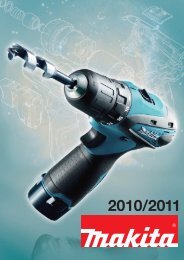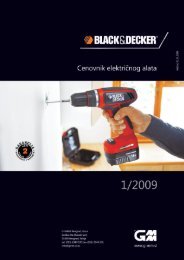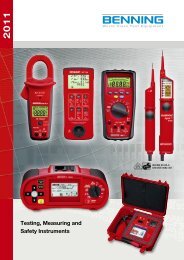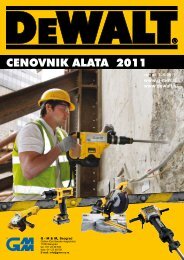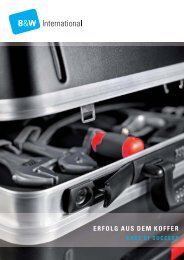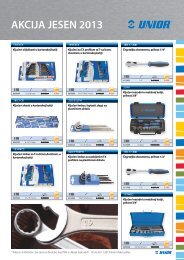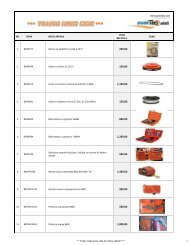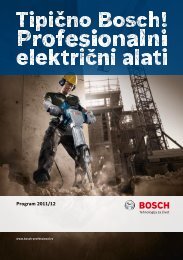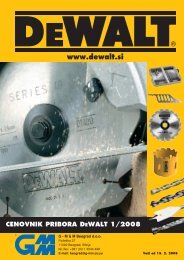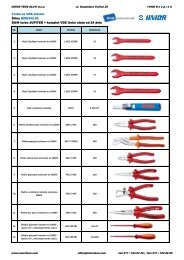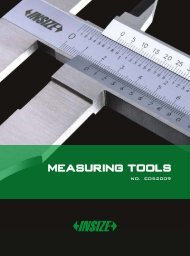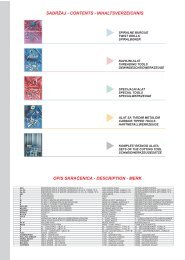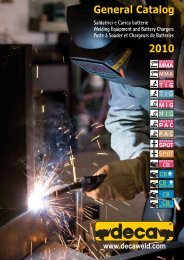Cut-off Wheels
Cut-off Wheels
Cut-off Wheels
You also want an ePaper? Increase the reach of your titles
YUMPU automatically turns print PDFs into web optimized ePapers that Google loves.
DIAMOND AND CBN PRODUCTS<br />
TECHtips<br />
❚ Avoid Grinding Steel<br />
• Avoid steel when grinding with diamond wheels. Keep the amount<br />
of steel ground to an absolute minimum.<br />
• On brazed tools, use an aluminum oxide wheel to back <strong>off</strong> the<br />
steel shank.<br />
• A high lubricity grinding fluid should be used.<br />
• For some steels, an armored (AMD) diamond wheel may prove<br />
most economical.<br />
❚ Work Support – Use Rigid Work Support<br />
• All workpieces should be supported firmly during the grinding process.<br />
Any amount of vibration will cause wheel wear and produce chatter or<br />
wave marks on the ground surface.<br />
• On work ground between centers, centerholds should be<br />
properly prepared.<br />
• Minimize work overhang.<br />
• If the ground work is supported by a work finger, ensure the finger is<br />
strong enough to provide vibration-free support.<br />
❚ Coolant – Grind Wet<br />
• Diamond wheels should be used with a full flood coolant properly<br />
directed toward the grinding zone. Water with a rust inhibitor is<br />
recommended.<br />
• Vitrified diamond wheels should be used only with a coolant.<br />
• When a flood application can not be used, try a mist or<br />
spray application.<br />
- Use compressed air to “atomize” water or soluble oil.<br />
- Direct the spray at the grinding zone to help dissipate heat and<br />
prevent heat damage to the work.<br />
❚ Feeds – Avoid Excessive Feeds<br />
• Excessive feeds will result in premature wheel wear. Excessive feed<br />
rates are characterized by:<br />
- A hard grinding sound<br />
- Chatter<br />
- Burn<br />
- High wheel wear rate<br />
- Vibration<br />
DIAMOND AND CBN PRODUCTS<br />
It is the user’s responsibility to refer to and comply with ANSI B7.1<br />
SPEC check<br />
Troubleshooting Guide – Dry Grinding<br />
PROBLEM POSSIBLE CAUSES SUGGESTED CORRECTION<br />
Burning Wheel loaded or glazed Dress wheel with a dressing stick<br />
(excessive heat) Excessive feed rate Reduce infeed of wheel or workpiece<br />
Wheel too durable<br />
Use freer cutting specification or slow down wheel speed<br />
Poor finish Grit size too coarse Select a finer grit size<br />
Excessive feed rate<br />
Reduce infeed of wheel or workpiece<br />
Chatter Wheel out of truth True wheel; ensure it is not slipping on mount<br />
(See “Mounting, Truing and Dressing Guide”)<br />
Troubleshooting Guide – Wet Grinding<br />
PROBLEM POSSIBLE CAUSES SUGGESTED CORRECTION<br />
Burning Wheel glazed or loaded Re-dress wheel<br />
(excessive heat) Poor coolant placement Apply coolant directly to wheel/workpiece interface<br />
Excessive material removal rate<br />
Reduce downfeed and/or crossfeed<br />
Poor finish Excessive dressing Use lighter dressing pressure<br />
Stop dressing as soon as wheel starts to consume stick rapidly<br />
Grit size too coarse<br />
Select a finer grit size<br />
Poor coolant flow or location<br />
Apply heavy flood so it reaches wheel/work interface<br />
Chatter Wheel out of truth True wheel; ensure it is not slipping on mount<br />
Wheel will not cut Glazed by truing Dress lightly until wheel opens up<br />
Wheel loaded<br />
Dress lightly until wheel opens up<br />
Increase coolant flow to keep wheel surface clean<br />
Never run wheel with coolant turned <strong>off</strong><br />
Slow cutting Low feeds and speeds Increase feed rate; increase wheel speed<br />
(Observe maximum wheel speed)<br />
Short wheel life Incorrect coolant flow Apply coolant to flood wheel/work surface<br />
Low wheel speed<br />
Increase wheel speed (observe maximum operating speed)<br />
Excessive dressing<br />
Use lighter dressing pressure<br />
Wheel too soft or too hard<br />
Change grit or grade; use higher concentration<br />
191<br />
Wheel Speed Calculation:<br />
TO CONVERT M/S TO SFPM: MULTIPLY M/S X 196.85 = SFPM<br />
TO CONVERT SFPM TO M/S: DIVIDE SFPM BY 196.85 = M/S<br />
TO CONVERT RPM TO SFPM: MULTIPLY WHEEL DIAMETER X RPM X 0.262<br />
EXAMPLE: 40 M/S X 196.85 = 7874 SFPM<br />
EXAMPLE: 5423 SFPM ÷ 196.85 = 27.5 M/S<br />
EXAMPLE: 6" DIAMETER X 3450 RPM X 0.262 = 5423 SFPM<br />
M/S = Meters/Second RPM = Revolutions Per Minute SFPM = Surface Feet Per Minute



